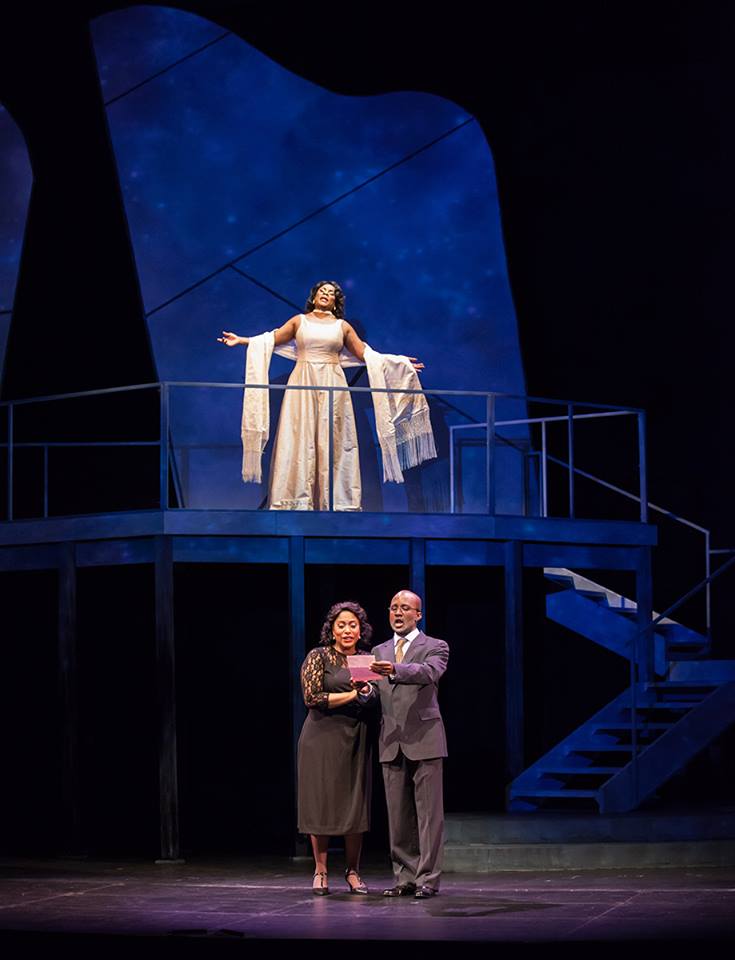Photo: Philip Groshong
Maria de Buenos Aires
Composed by Astor Piazzolla
Libretto by Horacio Ferrer
Conducted by Everett McCorvey
Directed by Jose Maria Condemi
A review by Annette Skaggs
Entire contents are copyright © 2022 by Annette Skaggs. All rights reserved.
I’ve been fortunate to study and enjoy many genres and variations of music, from classical to jazz to hip-hop and everything that lies in between. Among the styles that can be discovered in between is the music of South America and contained within that is tango.
Having had humble roots in the 19th century, the dance was forbidden since the couples danced in such close proximity. But this is the kind of music that cannot be extinguished. In the 1950’s Astor Piazzolla, who could be considered a savior of this art form, helped to reshape and reform the music into what is considered “nuevo tango” (new tango). It is from this nod to the past and the new tango that the modern style was resurrected.
Using a libretto from Horacio Ferrer, Piazzolla composed Maria de Buenos Aires as an operita, or as we more commonly refer to it, operetta.
Maria is set in the barrio of Buenos Aires in a Latin nightclub that features a flower-festooned steel spiral staircase that overlooks the club as well as the street. Outside of the club, one can see broken furniture and general disarray. The club itself is actually inviting with tables and chairs, a prominent lighted marquee sign that says MARIA, and a structure of chairs that are assembled in a way that looks like a tornado.
Another inviting aspect of the club is the jazz ensemble that is assembled on the stage and led by its conductor Everett McCorvey. Strings, guitar, flute, percussion, and piano sit on a raised platform, while in the center, under a cover sits Rodolfo Zanetti, who plays one of the most important instruments of the tango sound: the bandoneón. The whole of the musical ensemble were en fuego!
If you are not familiar with the bandoneon, it is akin to an accordion but has different sets of buttons for each hand. When the buttons are pressed the sound that is extracted depends on the squeeze of the instrument, whether it is being expanded or contracted.
At its core Maria de Buenos Aires is a commentary on the poor and the indignities that some may face in their fight for survival. The plot is surreal: Maria was born on a day that God himself was drunk, she then found herself a slave to the call of the tango and becomes a sex worker, is then killed and her ghost then haunts the streets of Buenos Aires. Through poetry, she is soon resurrected as virginal but then gives birth to a child that could be herself.
With many references to Catholicism strewn throughout there are clear allusions to the Blessed Virgin Mary and Mary Magdalene from the New Testament.
The cast is small. Raquel Winnica-Young plays El Duende, who is born of a mythical creature in Latin American culture as someone who does good, bad and/or is mischievous. In this iteration of the myth, El Duende is evil and repentant. This part does very little singing, more narration but with a melody underneath for layering. Winnica-Young’s portrayal was touching in many spots, but perhaps overly dramatized in others.
Luis Ledesma portrays El Payador who is exactly what the title implies, he serves as the storyteller of the tango opera, the gaucho minstrel. Vocally he has a fine voice for the role, but the microphones that were used on the performers fed into a speaker that made words and sounds distorted. It was very hard to understand any vocalizations, whether it was in Spanish or English.
The lead character of Maria, portrayed by Kelly Guerra was well cast. She had both sultriness and innocence about her. Despite there only being a few moments to shine vocally she was confident in that light.
The remainder of the ensemble had their places within the staging, but the attention was certainly given to the featured tango dancers: Fernanda Ghi and Gaston Oguin. Every nuance, step, and twirl was pure sizzle. Absolutely electric from start to finish.
Costumes (Charles Heightchew) and props were right on target for the feel of the barrio and as I stated the open, eclectic quality of the set (by Andrew Boyce) was as close to perfect as one can get for this piece.
There were some issues that I had trouble with: the clarity of hearing the principles, supertitles that didn’t seem to link up, and I wanted more singing. The latter is something I’d have to take up with the composer.
It is not often that Maria de Buenos Aires is given a full production and I appreciate that the Kentucky Opera took a chance and did so. Was it perfect, no, but it is something that I very well may put into my repertoire of listening again and again.
Bravi Tutti
Maria de Buenos Aires
November 11 & 13, 2022
Kentucky Opera
The Brown Theatre
315 West Broadway
Louisville, KY 40202
KYopera.org
Annette Skaggs is heavily involved as an Arts Advocate here in Louisville. She is a freelance professional opera singer who has performed throughout Europe and in St. Louis, Cincinnati, Boulder, Little Rock, Peoria, Chicago, New York and of course Louisville. Aside from her singing career, she has been a production assistant for Kentucky Opera, New York City Opera, and Northwestern University. Her knowledge and expertise have developed over the course of 25+ years’ experience in the classical arts.





